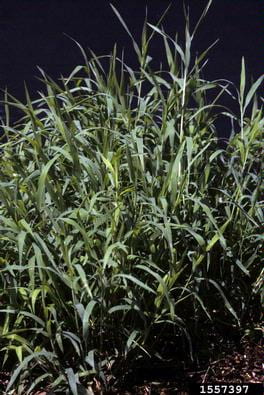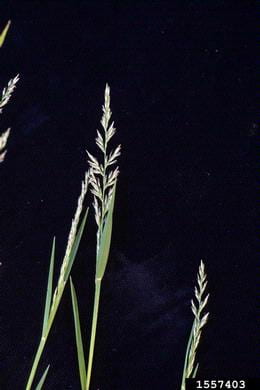Scientific name: Muhlenbergia fronds
Other names: smooth wire-stemmed muhly, mexican drop-seed, satin-grass, wood-grass, knot-root-grass
Wirestem muhly (Muhlenbergia frondosa) is a perennial grass native to North America. It is common in field crops where conventional corn is grown in New York. It grows well in fertile, moist soil conditions in part-shade and shade. It has a fibrous root system and spreads both by seed and by underground runners (rhizomes).

Multiple wirestem muhly plants in a group.
Photo by Ohio State Weed Lab, Ohio State University, via Bugwood.org.
Identification
Leaves are flat, hairless, with coarse margins.
Leaf blade size: 0.12-0.3 in (3-7 mm) wide by 3.9 in (10 cm) long
Similar species
Table 14: Shows wirestem muhly (Muhlenbergia frondosa) similarities and differences in identification compared to its similar species: nimblewill (Muhlenbergia schreberi).
Wirestem muhly similar species
Table 14: Shows wirestem muhly (Muhlenbergia frondosa) similarities and differences in identification compared to its similar species: nimblewill (Muhlenbergia schreberi).| Species | Wirestem muhly (Muhlenbergia frondosa) | Nimblewill (Muhlenbergia schreberi) |
|---|---|---|
| Similarities | Perennial; leaf bud rolled; ligule membranous | Perennial; leaf bud rolled; ligule membranous |
| Differences | Robust, taller by 2-3 times; scaly, short, and thick rhizomes | Produces stolons |
Management
Chemical
Use CCE Eastern NY Horticulture’s herbicide lookup tool to look up the efficacy of herbicides on wirestem muhly (last species in the table). Commodity-specific guidance can be found in the Cornell Crop and Pest Management Guidelines.
Non-chemical
Mechanical: Wirestem muhly can be controlled by mowing, plowing, and disking. Severe tillage in the spring combined with chemical control can be effective. Preventing seed set is crucial to preventing the spread of this weed. Tillage may not be efficient if this weed is established.
Herbicide resistance
Reported as of 2021:
None
Visit the International Herbicide-Resistant Weed Database homepage for more information on resistance.
References
Uva R H, Neal J C, DiTomaso J M. 1997. Weeds of the Northeast. Book published by Cornell University, Ithaca NY. The go-to for weed ID in the Northeast; look for a new edition sometime in 2019.
PennState Extension has a wirestem muhly profile that focuses on management in agronomic crops.
For New York State specific distribution and common names for wirestem muhly check out the New York Flora Atlas site.
Minnesota Wildflowers has a wirestem muhly profile with more info on biology.





